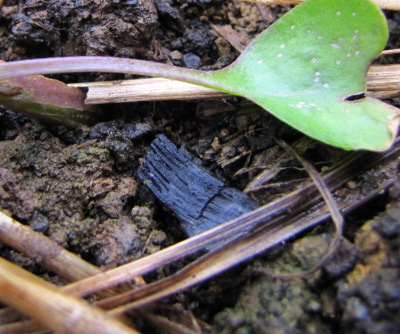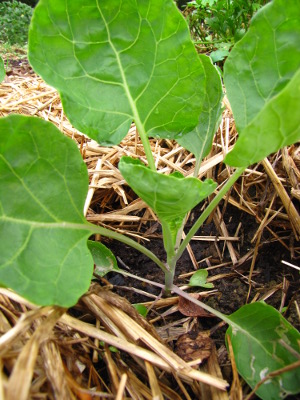
The effects of biochar on a home garden
 Several readers have asked
what sort of on-the-ground results we see from our biochar
experiments.
Over the last couple of years, I've applied the winter's charcoal
(separated from the ashes and activated with urine) to half of various
garden beds, keeping notes on the location. The idea is that I
should be able to compare the biochar half to the control half and get
some pretty good anecdotal evidence of the changes biochar makes in the
soil.
Several readers have asked
what sort of on-the-ground results we see from our biochar
experiments.
Over the last couple of years, I've applied the winter's charcoal
(separated from the ashes and activated with urine) to half of various
garden beds, keeping notes on the location. The idea is that I
should be able to compare the biochar half to the control half and get
some pretty good anecdotal evidence of the changes biochar makes in the
soil.
The trouble is that both
halves of the beds look the same. And it occurred to me, as I
went out to monitor each one, that biochar's ability to expand the soil
microorganism population could carry over into the untreated half of
the bed. Soil fungi can send their hyphae quite a distance
through the earth, so maybe the control half of the bed gets similar
benefits to the biochar half?
If that hypothesis was
correct, I should be comparing the growth of plants in the biochar beds
to plants in neighboring beds. The trouble is that our garden is
extremely diverse, and no two beds get the same treatment.
Depending on what's planted there, a bed might get one, two, or three
top-dressings of manure per year, or --- if I have some on hand --- the
soil may instead benefit from worm compost. It might get kill
mulched with cardboard if it gets too weedy, or might just keep a
gentle coat of straw. I might grow three rounds  of buckwheat between spring
and fall vegetables, might plant oats or oilseed radishes after summer
cucumbers die back, or might plant no cover crops at all. And, of
course, the actual vegetable grown in each bed can affect the soil,
with greedy corn depleting many nutrients but kind beans giving some
nitrogen back. This is the reason I'd hoped to do a within-bed
trial --- comparing the effects of biochar between beds is nearly
impossible.
of buckwheat between spring
and fall vegetables, might plant oats or oilseed radishes after summer
cucumbers die back, or might plant no cover crops at all. And, of
course, the actual vegetable grown in each bed can affect the soil,
with greedy corn depleting many nutrients but kind beans giving some
nitrogen back. This is the reason I'd hoped to do a within-bed
trial --- comparing the effects of biochar between beds is nearly
impossible.
So, my conclusion is no
conclusion. Biochar either doesn't help, or it does. (It
definitely doesn't seem to hurt.) Since we have nothing else
pressing to do with the waste from our wood stove, I'll keep adding
biochar to our soil and maintaining notes on the locations, and maybe
I'll see long term effects that aren't visible after a mere year and a
half.
How about you? Do
you have solid evidence of the effects of biochar in your garden?
If so, how did you process and apply the charcoal and what was its
original source?
Want more in-depth information? Browse through our books.
Or explore more posts by date or by subject.
About us: Anna Hess and Mark Hamilton spent over a decade living self-sufficiently in the mountains of Virginia before moving north to start over from scratch in the foothills of Ohio. They've experimented with permaculture, no-till gardening, trailersteading, home-based microbusinesses and much more, writing about their adventures in both blogs and books.
Want to be notified when new comments are posted on this page? Click on the RSS button after you add a comment to subscribe to the comment feed, or simply check the box beside "email replies to me" while writing your comment.

Last winter was my first full winter utilizing the wood insert. I saved all the ashes and char in pile then spread it all and mixed it well into my compost. Between that, the compost and utilizing agricultural gypsum my plants are all doing so well this year, even the tomatoes aren't getting burned like everyone else around me.
I know it helps a bit. At least I don't have to worry about adding lime since my ashes do that for the soil. But tough to say what it improve since I started with the gypsum this year and we had such a warm winter.
I use rice hull charcoal in my garden. And like Anna, I haven't noticed such a big difference, good or bad. I didn't pre-charge my charcoal with nitrogen, I just added it with compost. The areas I did add it to are growing well, but like Anna, so are the other areas. One positive thing is the soil color has darkened and warmed up faster in the spring.
Marco --- I recommend being careful with wood ashes, unless you do a soil test and find out your garden soil is acidic. Many folks throw lime and wood ashes on as a matter of course, but it's quite possible to sweeten your soil too much. You'll have to check back in a couple of years and tell how your additions have helped or hindered!
Eric --- Soil warming is the one change I was able to see immediately after application too. So, if nothing else, there's that! (A good reason to concentrate my applications in the area that I use for early spring gardening.)